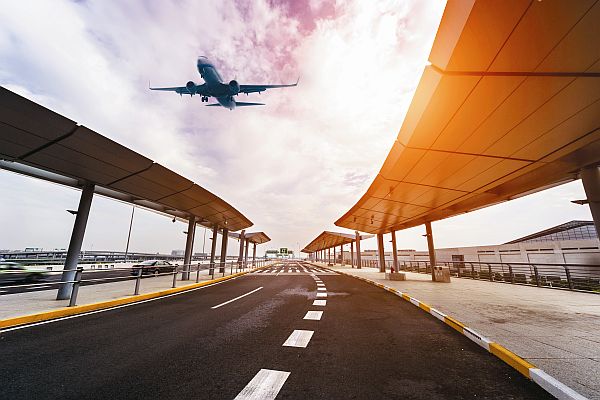Published on the 11/06/2015 | Written by Donovan Jackson

If there is an industry that has had to respond to the impact of technology then travel is it. Donovan Jackson explores how technology is transforming everything from booking flights to catching a taxi and managing travel expenses…
Over the past two decades, advances in technology have fundamentally altered the way the travel industry conducts its business. The continuously shifting technology landscape has increased efficiencies, improved automation, amplified customer knowledge and created a whole host of new business opportunities for those quickest to capitalise on these changes. It’s cool rather than scary, too, thanks to ease of use: today, it is simple to make bookings via computer or mobile phone, receive travel updates, select airline seats, check into hotels, hire and return rental cars and even find nearby restaurants or sightseeing opportunities through mobile apps. And you can keep track of all the costs incurred along the way to keep the office accountants happy back home. “We now find ourselves in the ‘Age of Traveller Power’,” he says. “Travellers today are supremely-informed and demand better service during their entire travel experience. They are becoming increasingly distinctive, travelling further and for varying reasons, with new channels to express their aspirations for travel.” Carter says personalisation is having a profound impact on the travel industry. “This should compel travel players to adapt their approach to appeal to different customer types who are searching for unique and personal travel experiences,” he says. His view is echoed by Julia Raue, Air New Zealand CIO, but she explains that staying ahead in a technologically driven world doesn’t start with focusing on technology. Instead, “we invest a considerable amount of time listening to what our customers have to say about the products and service we offer and focus on what truly matters to them,” she says. That’s putting the horse in front of the cart, rather than the other way round, and gives rise, Raue continues, to investing in technology which enhances the customer experience. “For instance, we have been focusing on mobile-enabled travel and how we can best support our customers on the day of travel in particular.” Disruption is not a dirty word But even as new, information-powered travel services emerge, existing ones haven’t disappeared. “The ability for ‘Joe Blow’ to make reservations directly with the airlines certainly did have an impact, as a significant portion of the ‘easy’ tickets went to the internet,” confirms Derek Sullivan, general manager of Auckland-headquartered retail travel franchise TravelSmart. The key word there is ‘easy’: “Whether domestic or Tasman, these low-value, simple trips just aren’t the business of the travel agent any longer. They are booked directly with the airline, or through the various ticket search engines.” Is this a disaster? No, it’s anything but, says Sullivan. “The net result for agencies is that we deal with more complex, high value travel arrangements where the service offered includes knowledge and experience. And for that, you can charge a margin.” With disruption comes pace Information accessibility and the systemic improvement in efficiencies which arise from modernisation have had a further effect, he says: more people travel and there is a far greater variety of services available at better prices. In effect, says Sullivan, there is a bigger cake to be divvied up. “While there are some areas [where employment has become automated] where fewer people are employed, in retail in general, no. We still need people to interact with customers.” However, Tony Dominey, editor of Travel Today, says travel is no different to any other retail industry and that it is experiencing dramatic change at the hands of the internet. “You know how people go in to shops, try on clothing then go buy online? It happens all the time and travel is no different.” Dominey reckons that while many in the travel industry tend to complain about the internet impacting on their businesses, they need to take advantage of it like every consumer is doing. “Customers constantly want ‘cheap, cheap, cheap’, but they also want the service that comes with a travel agent. You can’t have it both ways; agents need to use technology to control costs while also enhancing the value they add.” Consumer-led change Through the wonders of information technology – and a systemic view really is necessary – information which was once the preserve of the few has opened up to almost anyone. As the business information systems of airlines (Computerised Reservation Systems, and later Global Distribution Systems) opened up to travel agents first, and later thanks to Internet Booking Engines, directly to travellers themselves, new value propositions have emerged. Most notable are the innovators who understand that packaging and presenting information in a convenient and easy-to-consume manner equates to a value proposition. This has led to the emergence of services like Australia’s WebJet and the USA’s Expedia, which aggregate ticket price information and make it easier for consumers to choose the options that best meet their budget and other needs. Services like TripAdvisor, too, have emerged to make it easier to choose where to go. These organisations, and many others like them, are in effect virtual travel agents, dealing in information in order to connect buyers and sellers; they employ thousands of people and sell a lot more than just airline tickets and other travel products. Air New Zealand’s Raue says this environment means existing businesses are compelled to innovate: “You only have to look at other industries to understand the risk of disruption. [As a result] we see ourselves as not simply an airline, but a travel company which delivers end-to-end travel experiences. We are constantly looking at ways to enhance the customer experience and if something is not part of our core business, we will look to partner with organisations which can help us to improve the experience we deliver.” Corporates on catch-up Curts adds that what’s really important in the business-to-business world is convenience and ease of use. “Your average corporate travel booker should be motivated to use [given systems] and stay within the environment. That means the company then has maximum leverage to negotiate with suppliers, and control costs.” New B2B Services Concur Australia managing director Matt Goss says a whole ecosystem of services surrounding travel has arisen, driven by technology disruption. “That’s unquestionably the case. Just from our own perspective, for example, after opening our platform [to external third parties] and creating a $150-million fund, we’ve added hundreds of partners who have developed applications on top of Concur to add further value to customers.” Goss says the key to success in providing innovative solutions is the ability to interoperate and integrate with the existing travel industry services and information. In the context of expense management, he notes that a lot of travel today is procured from outside the traditional corporate booking channels, expanding the information sources which must be taken into account. “Our customers are saying ‘how can we get visibility across and also outside the travel agency’. Corporate travel agencies still have an important role to play, but you have to be able to catch the information which happens outside of that, too, and incorporate it into expense management.” He agrees with Curts on the topic of usability; “It comes down to this: if you download and use an app and it delivers a good experience, you use it again. If not, you delete it.” Goss adds that business travellers want something which is easy to use anytime, anywhere. “Mobility and the cloud are very important. Then, businesses are looking for compliance, control and visibility. What we’ve seen is a shift in the last couple of years, where expense management has gone from a nice to have, to no longer being optional – after all, travel and entertainment is the second biggest controllable operational expense in a business, so it presents a considerable cost and compliance opportunity.” Travel is far from unique Raue concurs: “Customer expectations continue to evolve and we must offer product choices that meet their needs and enhance their experiences.” The emergence of smartphones and multiple easy-to-access and use personalised services and apps now means individuals can manage every aspect of travel from their pockets. … Where access and governance meet… Getting practical on building AI maturity… More than just cybersecurity… Asset-centric industries are ripe for an AI revolution, but without the hype… Are buyers looking for AI features? Or is the reverse more true? Tony Carter, Sydney-based managing director of Amadeus IT Pacific, provider of a reservation tool for travel agents known as a Global Distribution System or GDS explains how the travel game has changed thanks to technology disruption.
Tony Carter, Sydney-based managing director of Amadeus IT Pacific, provider of a reservation tool for travel agents known as a Global Distribution System or GDS explains how the travel game has changed thanks to technology disruption.
Before going any further, let’s address the elephant in the room: does the disruptive effect of technology put people out of work? This notion was dispelled by Adam Smith back in 1776, when air travel consisted of a brief ride in a Montgolfier balloon. Since then travel agents have had their heyday and are now often perceived as being up against the wall, with disruption as the firing squad.
Through his career in travel, Sullivan has noted how technology has changed the industry. “Travel is all about information and the industry has always been a big user of technology [see below], but it has stepped up to a new level. Airlines, for example, once rolled out sales deals on a planned basis throughout the year. That’s out the window, with some doing it daily. Similarly, hotels offer dynamic pricing which can change on a daily basis; ten years ago, it was one price for the whole year.”
Probably the arena in which the greatest change is happening is in consumer travel, as alluded to by Dominey. It is big business, too: globally, travel (and tourism) accounts for a total of 9.8 percent of the world gross domestic product (US$7.6 trillion) and supports nearly 277 million people in employment, according to the World Travel and Tourism Council.
Interviewed by iStart at NetSuite’s global conference in San Jose in the wake of selecting the ERP vendor for its financials, American Express Global Business Travel chief strategy officer Steve Curts says that consumer-led change is impacting on corporate travel. “Without a doubt there is strong demand from business users wanting to use the consumer services they see on everyday booking and airline systems. The expectation keeps going up and we have to respond or become irrelevant; user expectations are putting pressure on internal systems and IT teams to perform or get out of the way.”
One of the ways in which the cake has grown is through the emergence of new services which aren’t necessarily directly linked to travel itself. Expense management is one of these; done manually, accounting for business travel expenses quickly becomes a spreadsheet nightmare. That’s given rise to the emergence of automated expense management solutions like Concur, recently acquired by ERP behemoth SAP, and listed New Zealand company Serko.
While charting the use of technology in the travel industry is fascinating – and the level of disruption remarkable – as an industry, it is far from unique. The pervasive nature of devices and connectivity, which consistently awe with new capabilities, means disruption is the new normal. In summing up the effect of technology disruption on travel, Amadeus’ Carter might be speaking of any one of a number of vertical markets. “The travel industry is always faced with disruptions, but in a good way. This means we cannot expect customers to work around rigid traditional rules and technology. We must take a more emotional – rather than rational – approach and deliver in the way that suits travellers best,” he says.
A potted history of travel technology
Getting a ticket for a plane ride wasn’t always complex, but with the massive growth of the travel and tourism industry, it soon became so. After all, the airline industry has gone from zero passengers in 1909, to a projected 3.6 billion by 2016. As a result, information systems have aided the industry ever since they were available. The first automated booking system was introduced in 1947; the Electromechanical Reservisor was used by airline operators to find fares and seats, feeding this information to travel agents.More sophisticated reservations systems saw introduction in 1953, led by the SABRE (semi-automatic business research environment) reservation system. This and competing solutions would evolve into ‘computerised reservation systems’ (CRS) and from there to become the ‘globalised distribution systems’ (GDS) in use today. SABRE today is used by some 350,000 travel agents, 400 airlines, 100,000 hotels, 25 car rental brands, 50 rail providers and 14 cruise lines.Originally owned and operated by airlines, CRSs were later extended for the use of travel agents who could query the systems and make reservations from multiple airlines themselves; the GDSs were largely spun off as separate businesses.Further driving the accessibility of information from airline directly to passenger, the emergence of ‘internet booking engines’ (IBE), in practically universal use by airlines today, allow the direct booking and payment of fares by travellers themselves.FURTHER READING

Cyber resilience begins with modern identity security

Asset management leaders share AI insights

Identity security as a business transformer

Don’t run before you can walk with AI

The evolving role of AI in business technology



























